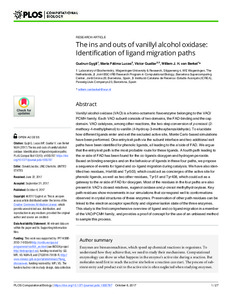The ins and outs of vanillyl alcohol oxidase: Identification of ligand migration paths

Visualitza/Obre
10.1371/journal.pcbi.1005787
Inclou dades d'ús des de 2022
Cita com:
hdl:2117/110493
Tipus de documentArticle
Data publicació2017-10-06
EditorPublic Library of Science
Condicions d'accésAccés obert
Llevat que s'hi indiqui el contrari, els
continguts d'aquesta obra estan subjectes a la llicència de Creative Commons
:
Reconeixement-NoComercial-SenseObraDerivada 4.0 Espanya
Abstract
Vanillyl alcohol oxidase (VAO) is a homo-octameric flavoenzyme belonging to the VAO/PCMH family. Each VAO subunit consists of two domains, the FAD-binding and the cap domain. VAO catalyses, among other reactions, the two-step conversion of p-creosol (2-methoxy-4-methylphenol) to vanillin (4-hydroxy-3-methoxybenzaldehyde). To elucidate how different ligands enter and exit the secluded active site, Monte Carlo based simulations have been performed. One entry/exit path via the subunit interface and two additional exit paths have been identified for phenolic ligands, all leading to the si side of FAD. We argue that the entry/exit path is the most probable route for these ligands. A fourth path leading to the re side of FAD has been found for the co-ligands dioxygen and hydrogen peroxide. Based on binding energies and on the behaviour of ligands in these four paths, we propose a sequence of events for ligand and co-ligand migration during catalysis. We have also identified two residues, His466 and Tyr503, which could act as concierges of the active site for phenolic ligands, as well as two other residues, Tyr51 and Tyr408, which could act as a gateway to the re side of FAD for dioxygen. Most of the residues in the four paths are also present in VAO’s closest relatives, eugenol oxidase and p-cresol methylhydroxylase. Key path residues show movements in our simulations that correspond well to conformations observed in crystal structures of these enzymes. Preservation of other path residues can be linked to the electron acceptor specificity and oligomerisation state of the three enzymes. This study is the first comprehensive overview of ligand and co-ligand migration in a member of the VAO/PCMH family, and provides a proof of concept for the use of an unbiased method to sample this process. Enzymes are bionanomachines, which speed up chemical reactions in organisms. To understand how they achieve that, we need to study their mechanisms. Computational enzymology can show us what happens in the enzyme’s active site during a reaction. But molecules need first to reach the active site before a reaction can start. The process of substrate entry and product exit to the active site is often neglected when studying enzymes. However, these two events are of fundamental importance to the proper functioning of any enzyme. We are interested in these dynamic processes to complete our understanding of the mode of action of enzymes. In our work, we have studied substrate and product migration in vanillyl alcohol oxidase. This enzyme can produce the flavour vanillin and enantiopure alcohols, but also catalyses other reactions. The named products are of interest to the flavour- and fine-chemical industries.
CitacióGygli, G. [et al.]. The ins and outs of vanillyl alcohol oxidase: Identification of ligand migration paths. "PLoS Computational Biology", 6 Octubre 2017, vol. 13, núm. 10.
ISSN1553-734X
Col·leccions
| Fitxers | Descripció | Mida | Format | Visualitza |
|---|---|---|---|---|
| The INS AND OUTS.pdf | 11,40Mb | Visualitza/Obre |


